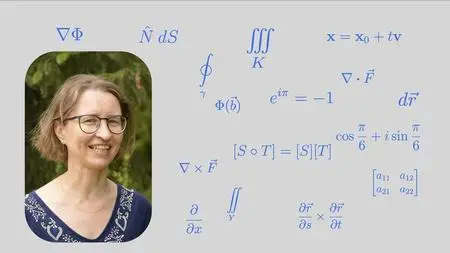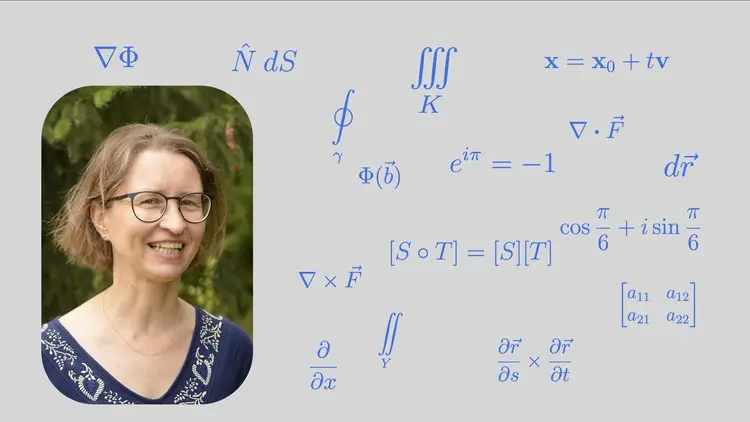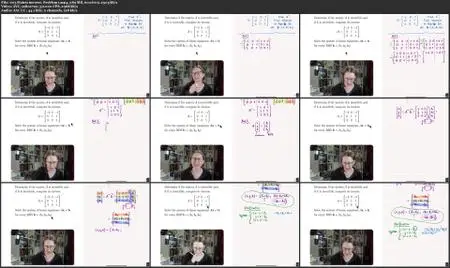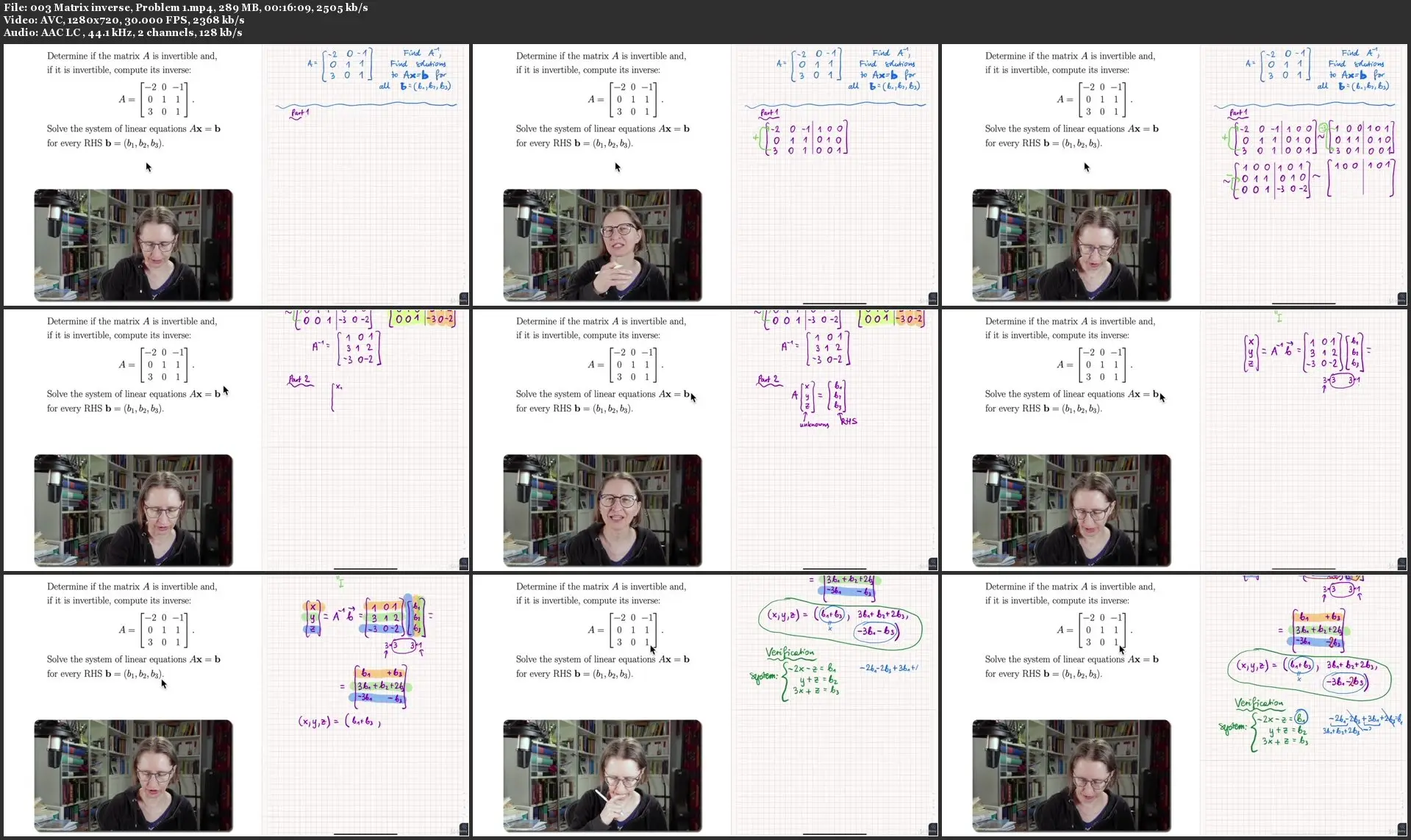Linear Algebra and Geometry 1
.MP4, AVC, 1280x720, 30 fps | English, AAC, 2 Ch | 45h 55m | 34.42 GB
Instructor: Hania Uscka-Wehlou
.MP4, AVC, 1280x720, 30 fps | English, AAC, 2 Ch | 45h 55m | 34.42 GB
Instructor: Hania Uscka-Wehlou
Systems of equations, matrices, vectors, and geometry
What you'll learn
How to solve problems in linear algebra and geometry (illustrated with 175 solved problems) and why these methods work.
Solve systems of linear equation with help of Gauss-Jordan or Gaussian elimination, the latter followed by back-substitution.
Interpret geometrically solution sets of systems of linear equations by analysing their RREF matrix (row equivalent with the augmented matrix of the system).
Matrix operations (addition, scaling, multiplication), how they are defined, how they are applied, and what computational rules hold for them.
Matrix inverse: determine whether a matrix is invertible; compute its inverse: both with (Jacobi) algorithm and by the explicit formula; matrix equations.
Determinants, their definition, properties, and different ways of computing them; determinant equations; Cramer's rule for n-by-n systems of equations.
Vectors, their coordinates and norm; geometrical vectors and abstract vectors, their addition and scaling: arithmetically and geometrically (in 2D and 3D).
Vector products (scaling, dot product, cross product, scalar triple product), their properties and applications; orthogonal projection and vector decomposition.
Analytical geometry in the 3-space: different ways of describing lines and planes, with applications in problem solving.
Compute distances between points, planes and lines in the 3-space, both by using orthogonal projections and by geometrical reasoning.
Determine whether lines and planes are parallel, and compute the angles between them (using dot product and directional or normal vectors) if they intersect.
How to geometrically interpret n-by-2 and n-by-3 systems of equations and their solution sets as intersection sets between lines in 2D or planes in 3D.
Understand the connection between systems of linear equations and matrix multiplication.
Invertible Matrix Theorem and its applications; apply determinant test in various situations.
Requirements
High-school maths, mainly arithmetics, some trigonometry
Description
Chapter 1 Systems of linear equations
S1. Introduction to the course
S2. Some basic concepts
You will learn: some basic concepts that will be used in this course. Most of them are known from high-school courses in mathematics, some of them are new; the latter will appear later in the course and will be treated more in depth then.
S3. Systems of linear equations; building up your geometrical intuition
You will learn: some basic concepts about linear equations and systems of linear equations; geometry behind systems of linear equations.
S4. Solving systems of linear equations; Gaussian elimination
You will learn: solve systems of linear equations using Gaussian elimination (and back-substitution) and Gauss–Jordan elimination in cases of systems with unique solutions, inconsistent systems, and systems with infinitely many solutions (parameter solutions).
S5. Some applications in mathematics and natural sciences
You will learn: how systems of linear equations are used in other branches of mathematics and in natural sciences.
Chapter 2 Matrices and determinants
S6. Matrices and matrix operations
You will learn: the definition of matrices and their arithmetic operations (matrix addition, matrix subtraction, scalar multiplication, matrix multiplication). Different kinds of matrices (square matrices, triangular matrices, diagonal matrices, zero matrices, identity matrix).
S7. Inverses; Algebraic properties of matrices
You will learn: use matrix algebra; the definition of the inverse of a matrix.
S8. Elementary matrices and a method for finding A inverse
You will learn: how to compute the inverse of a matrix with Gauss–Jordan elimination (Jacobi’s method).
S9. Linear systems and matrices
You will learn: about the link between systems of linear equations and matrix multiplication.
S10. Determinants
You will learn: the definition of the determinant; apply the laws of determinant arithmetics, particularly the multiplicative property and the expansion along a row or a column; solving equations involving determinants; the explicite formula for solving of n-by-n systems of linear equations (Cramer's rule), the explicite formula for inverse to a non-singular matrix.
Chapter 3 Vectors and their products
S11. Vectors in 2-space, 3-space, and n-space
You will learn: apply and graphically illustrate the arithmetic operations for vectors in the plane; apply the arithmetic operations for vectors in R^n.
S12. Distance and norm in R^n
You will learn: compute the distance between points in R^n and norms of vectors in R^n, normalize vectors.
S13. Dot product, orthogonality, and orthogonal projections
You will learn: definition of dot product and the way you can use it for computing angles between geometrical vectors.
S14. Cross product, parallelograms and parallelepipeds
You will learn: definition of cross product and interpretation of 3-by-3 determinants as the volume of a parallelepiped in the 3-space.
Chapter 4 Analytical geometry of lines and planes
S15. Lines in R^2
You will learn: several ways of describing lines in the plane (slope-intercept equation, intercept form, point-vector equation, parametric equation) and how to compute other kinds of equations given one of the equations named above.
S16. Planes in R^3
You will learn: several ways of describing planes in the 3-spaces (normal equation, intercept form, parametric equation) and how to compute other kinds of equations given one of the equations named above.
S17. Lines in R^3
You will learn: several ways of describing lines in the 3-space (point-vector equation, parametric equation, standard equation) and how to compute other kinds of equations given one of the equations named above.
S18. Geometry of linear systems; incidence between lines and planes
You will learn: determine the equations for a line and a plane and how to use these for computing intersections by solving systems of equations.
S19. Distance between points, lines, and planes
You will learn: determine the equations for a line and a plane and how to use these for computing distances.
S20. Some words about the next course
You will learn: about the content of the second course.





